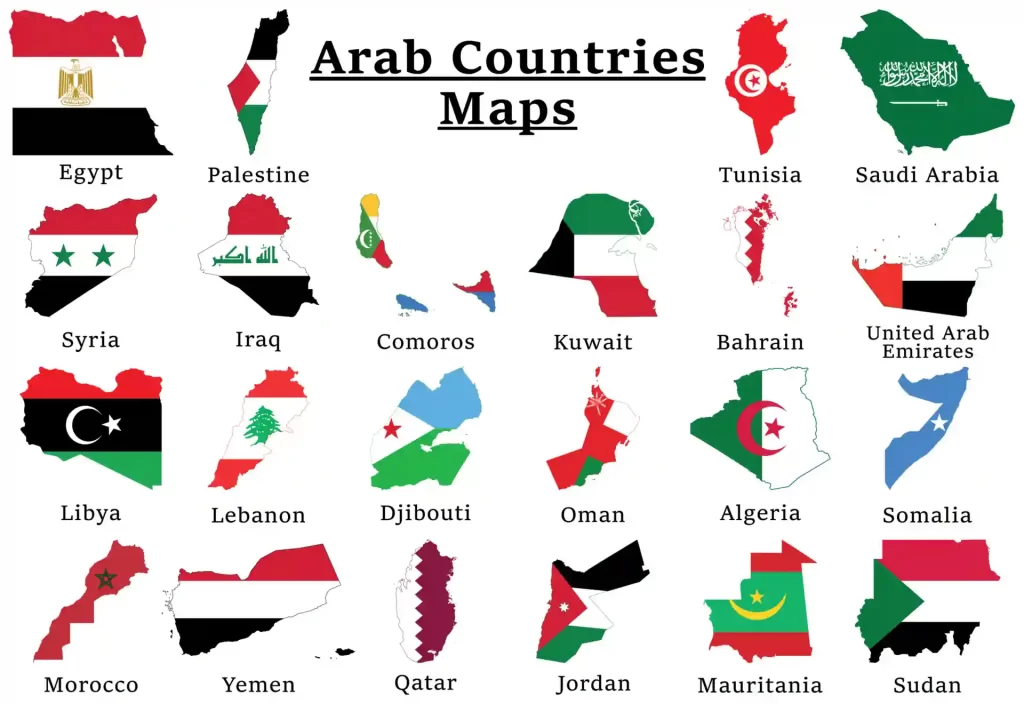In This Article
Arabic is a beautiful and complex language that is spoken by millions of people around the world. However, what many people don’t realize is that there isn’t just one Arabic dialect, but actually many different dialects of Arabic, while Modern Standard Arabic (MSA) is used as the standard written form of Arabic. In fact, the Arabic language is so diverse that it can often be difficult for speakers of different dialects to understand one another. In this blog post, we’ll explore the world of Arabic dialects, their differences, and their importance.
What are Arabic Dialects?
Dialects of Arabic refer to the different varieties of the Arabic language that are spoken in various regions across the Arab world. These dialects differ in pronunciation, vocabulary, and grammar from one another as well as from the formal written language of Modern Standard Arabic (MSA). Each dialect is unique to its region and has been shaped by many factors, including geography, history, and cultural influences.
Map of Arabic Speaking Countries
The Arabic dialects are so diverse that some linguists argue that they should be considered separate languages rather than dialects of the same language. Now, Let’s dig deeper and take a look at the map of Arabic speaking countries that would show all the countries that have different dialects spoken across the Arab world.

How Many Arabic Dialects are There?
Though it is difficult to determine a specific number, it is estimated that there are over 30 different dialects of Arabic spoken around the world. Some of the most common dialects include:
- Egyptian Arabic
- Levantine Arabic (spoken in Lebanon, Syria, Jordan, and Palestine)
- Gulf Arabic (spoken in Saudi Arabia, Kuwait, Bahrain, Qatar, Oman, and the United Arab Emirates)
- Maghrebi Arabic
- Tunisian Arabic
- Algerian Arabic
- Sudanese Arabic
- Yemeni Arabic
- Iraqi Arabic
- Mesopotamia Arabic
- Hassaniya Arabic
- Najdi Arabic
- Libyan Arabic
- Chadian
- Juba Arabic
These dialects are all mutually intelligible to some degree, but there are also some significant differences between them. For example, the pronunciation of some words can vary significantly from one dialect to another.
What Language Do Arabs Speak?
Arabs speak a variety of different languages, including Arabic, Kurdish, and Berber, among others. While Arabic is the most widely spoken language in the Arab world, it is not the only language spoken by Arabs.
Grammar Differences
Arabic dialects have many differences in grammar that set them apart from each other and from MSA. Here are some examples:
1. Verb conjugation: The way verbs are conjugated in Arabic dialects can be quite different from MSA. For example, in Gulf Arabic, the present tense is formed by adding a suffix to the verb, while in Levantine Arabic, the present tense is formed by adding a prefix.
2. Pronouns: Pronouns in Arabic dialects can vary in form and usage. In some dialects, such as Egyptian Arabic, the second-person singular pronoun is often dropped in informal speech.
3. Negation: Negation in Arabic dialects can be expressed in different ways. In some dialects, such as Gulf Arabic, the word “لا” (la) is used to negate a sentence, while in other dialects, such as Levantine Arabic, the word “مش” (mish) is used.
4. Gender: In some dialects, such as Moroccan Arabic, the gender of the speaker can influence the way certain words are pronounced or used. For example, the word for “my” in Moroccan Arabic changes depending on whether the speaker is male or female.
Vocabulary Differences
Arabic dialects also have many differences in vocabulary. While many words and expressions are shared between dialects, there are also many words that are unique to each dialect. Here are some examples:
1. Numbers: The way numbers are pronounced can vary greatly between dialects. For example, in Gulf Arabic, the number “three” is pronounced “thalatha”, while in Levantine Arabic, it is pronounced “tlete”.
2. Food: The names of dishes and food items can also vary between dialects. For example, the popular Levantine dish of stuffed grape leaves is called “warak enab” in Levantine Arabic, but “dolma” in Gulf Arabic.
3. Slang: Each dialect has its own unique slang words and expressions. For example, in Egyptian Arabic, the word “mesh” is often used to mean “no”, while in other dialects, it may not be used at all.
4. Loanwords: Many Arabic dialects have borrowed words from other languages over time, such as Turkish, French, and English. These loanwords can vary between dialects and can add to the diversity of vocabulary.
Standard Arabic vs Dialects
One of the most significant differences between Modern Standard Arabic (MSA) and the various dialects of Arabic is that MSA is the formal written language that is used in literature, news broadcasts, and official documents across the Arab world. However, it is not commonly spoken in daily life. In contrast, dialects are the different varieties of Arabic that are spoken by different groups of people. They are often used in everyday conversation, literature, music, and film.
What is the most common Arabic dialect
The most spoken Arabic dialect is Egyptian Arabic, which is spoken by over 68 million people in Egypt and around the world, followed by Levantine Arabic, Gulf Arabic, and Maghrebi Arabic. Because Egypt is considered to be the first Arab country to take the lead in making movies and series and to be a pioneer in Media field in general, it helped the Egyptian Arabic to be the most spoken Arabic dialect in the first place.
While it is not the official language of Egypt, it is the most widely spoken dialect in the country and is often used in media and entertainment. Egyptian Arabic has its own unique vocabulary and pronunciation, and is known for its use of the glottal stop. However, the most popular dialect of Arabic varies depending on the region and the individual speaker. Each dialect has its own unique characteristics that make it appealing to different people.
Easiest and Best Dialect to Learn
When it comes to learning Arabic, the question of “which dialect is the easiest or best to learn” is a difficult one to answer. However, the “easiest” Arabic dialect to learn may depend on your native language and your familiarity with Arabic. For example, some dialects may be easier for English speakers to learn because of their similarity to English, while others may be easier for speakers of other languages.
It ultimately depends on your personal goals and motivations for learning the language. However, some argue that Egyptian Arabic is one of the easiest dialects to learn due to its widespread use and the abundance of resources available for learners.
What If You Want to Learn More Than One Arabic Dialect?
Here are some tips for learning the different dialects of Arabic:
- Start by learning the standard Arabic dialect. This is the dialect that is used in formal writing and in the media. Once you have a good understanding of standard Arabic, you can start learning the other dialects.
- Search and collect enough information about the other dialects you want to learn in order to know what you’re going to study exactly and to make sure that the dialect you choose is the one you really want to learn. You can take a look at some of the Modern Standard Arabic and Egyptian Colloquial Arabic levels’ descriptions before deciding.
- Find a native speaker of the dialect you want to learn. This can be a friend, a family member, or a teacher. Having someone to practice with will help you to improve your pronunciation and grammar.
- Listen to and read as much Arabic as you can. This will help you to get used to the different sounds and rhythms of the language.
- Don’t be afraid to make mistakes. Everyone makes mistakes when they are learning a new language. The important thing is to keep practicing and to learn from your mistakes.
With time and effort, you can learn to speak and understand the different dialects of Arabic. It will be a rewarding experience that will open up a whole new world of possibilities.
Arabic Accent
The Arabic accent is one of the most distinct and recognizable accents in the world. It is characterized by its guttural sounds and unique pronunciation, which can vary depending on the dialect being spoken. Many people find the Arabic accent to be beautiful and intriguing, and it is often associated with the rich cultural heritage of the Arab world.
Conclusion
In conclusion, Arabic dialects differ from each other and from MSA in terms of grammar and vocabulary. While this can make learning Arabic dialects a challenge, it also adds to the richness and diversity of the language. By studying the different dialects and their unique features, you can deepen your understanding and appreciation of the Arabic language and culture.
However, it’s important to note that all these dialects have their own unique features and may take time and effort to learn. It’s always best to choose a dialect that you’re interested in and motivated to learn, and to seek out resources and materials that are tailored to that dialect. With dedication and practice, you can learn any Arabic dialect you choose!

